人教版八年级英语第九单元Unit9教案
- 格式:doc
- 大小:87.93 KB
- 文档页数:10
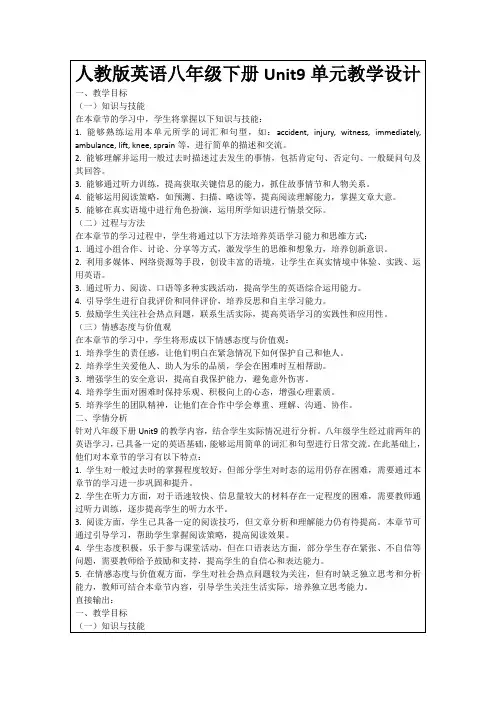
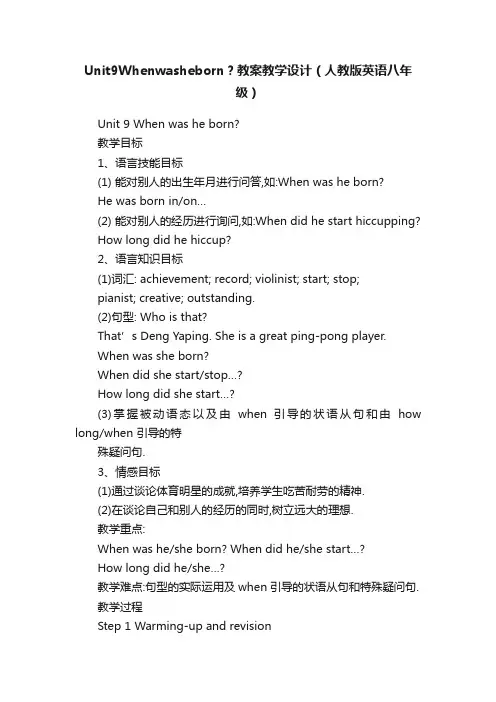
Unit9Whenwasheborn?教案教学设计(人教版英语八年级)Unit 9 When was he born?教学目标1、语言技能目标(1) 能对别人的出生年月进行问答,如:When was he born?He was born in/on…(2) 能对别人的经历进行询问,如:When did he start hiccupping?How long did he hiccup?2、语言知识目标(1)词汇: achievement; record; violinist; start; stop;pianist; creative; outstanding.(2)句型: Who is that?That’s Deng Yaping. She is a great ping-pong player.When was she born?When did she start/stop…?How long did she start…?(3)掌握被动语态以及由when 引导的状语从句和由how long/when 引导的特殊疑问句.3、情感目标(1)通过谈论体育明星的成就,培养学生吃苦耐劳的精神.(2)在谈论自己和别人的经历的同时,树立远大的理想.教学重点:When was he/she born? When did he/she start…?How long did he/she…?教学难点:句型的实际运用及when引导的状语从句和特殊疑问句.教学过程Step 1 Warming-up and revision(1) Intercourse(2) A guessing gameGet the students to review how to describe the famous people.T:. Let’s play a guessing game. I will tell you something abouta famous woman. Please listen to me carefully, and try to guess who sheis. She is Chinese. She was born in 1973.She plays ping-pong very well. She is short. She is very great.Do you know who she is ?S: Is she Deng Yaping ?T: Yes, you are right . Now please try to describe the famous personsStep 2 PresentationThis activity introduces the difficult points.A: When did Deng Yaping start playing ping-pong?B: She started playing ping-pong in 1978.A: When did she stop playing ping-pong?B: She stopped in 1997.A: How long did she play ping-pong?B: She played for 19 years.1、Ask the students to practice the sample conversation, then makeup similar conversations.2、 Ask several students to perform their conversations.3、Learning the new words.Step 3 Practice and listenNow we are going to talk about two unusual people.Look at this picture in section A 2a and the chart.T: What are their names ?S: The man is Charles Smith and the woman is Donna Green.T: What are they doing ?S: Charles Smith is hiccupping. Donna Green is sneezing.(Help them answer)T: What kinds of world record did they have ?S1: Charles Smith had a world record for hiccupping.S2: Donna Green had a world record for sneezing.T: How long did Charles Smith hiccup ?S3:He hiccupped for 69 years and 5 months.T: How long did Donna Green sneeze ?Let students listen to the tape and fill in the “How long” column inthe chart.Let students listen again and fill in the “started” and “stopped”columns.Get the students listen and write ,then check the answers.Step 4 DrillAsk some pairs of students to perform the conversations.T: You got all the answers right now. Let’s come to section A 2c pairwork. Please fill in the blanks with information from the listening.Ask two pairs of students to Practice the conversations.T: You did very well.I’d like you to work in pairs and make the same kind of conversationabout Donna.S1:How long did Charles Smith hiccup?S2:He hiccupped for 69 years and 5 months.S1:How long did he start hiccupping?S2:He started in 1922.S1:When did he stop hiccupping?S2:He stopped in 1990.Ask several pairs to act it out.Step 5 Sum-upThink about what we learn todayStep 6 Homework1)Write down a list of famous stars about their ages, birthdays, hobbiesand achievements2)Ask your parents birthdays and help them do something.板书设计:Unit 9 When was he born?He was born in/on…When did he start hiccupping? How long did he hiccup?Who is that?That’s Deng Yaping. She is a great ping-pong player.She started playing ping-pong in 1978.。
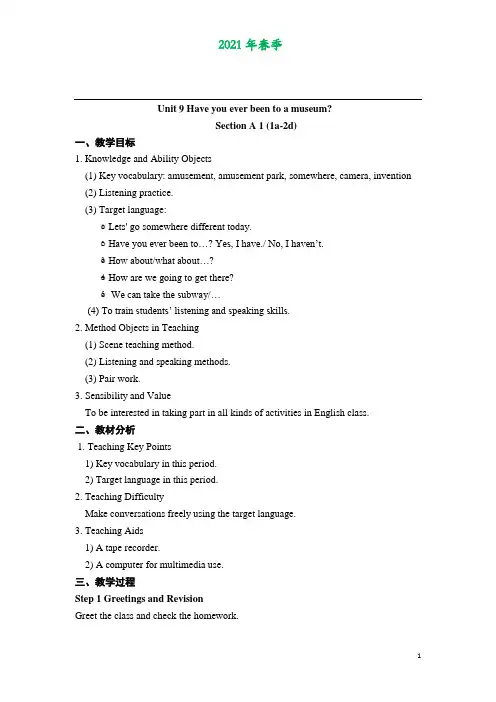
2021Unit 9 Have you ever been to a museum?Section A 1 (1a-2d)一、教学目标1. Knowledge and Ability Objects(1) Key vocabulary: amusement, amusement park, somewhere, camera, invention(2) Listening practice.(3) Target language:○1 Lets' go somewhere different today.○2Have you ever been to…? Yes, I have./ No, I haven’t.○3How about/what about…?○4 How are we going to get there?○5We can take the subway/…(4) To train students’ listening and speaking skills.2. Method Objects in Teaching(1) Scene teaching method.(2) Listening and speaking methods.(3) Pair work.3. Sensibility and ValueTo be interested in taking part in all kinds of activities in English class.二、教材分析1. Teaching Key Points1) Key vocabulary in this period.2) Target language in this period.2. Teaching DifficultyMake conversations freely using the target language.3. Teaching Aids1) A tape recorder.2) A computer for multimedia use.三、教学过程Step 1 Greetings and RevisionGreet the class and check the homework.2021 教案等集合Step 2 Lead-in1. Guess the places of the pictures. They are the British Museum, space museum, history museum, water park, zoo, amusement park. Lead in sentence patterns:“ Have you ever been to …?”2. SpeakingGet students to work in pairs to practice the conversation: “ Have you ever beento…” “Yes, I have/ Not, I haven’t. ” Step 3 Pre-listening 1. Work on 1a.T: OK. Now open your books on Page 65. In Part 1a, 6 places are given. Pleaseread the names of these places. (Teacher writes the names on the blackboard.) Which of these places would you like to visit? Rank them from 1 to 6. 2. Talk about the pictures. Step 4 Listening1. Listen and choose the best answer. The first and the second question aim to listening to time, and the third one aims to listen for the relationship. This activitytrains students’ listening ability for listening for specific relationship. 1) When did Sarah visit the National Science Museum? A. Today B. Yesterday C. Last year 2) When did Claudia visit the nature museum? A. last year B. last summer C. Last school trip3) What may the relationship be between the two speakers? A. Friends B. Teacher and student C. Mother and kid.Keys: CCAStep 5 SpeakingAsk and answer in pairs.2021A: let’s go somewhere different today.B: OK. Where do you want to go?A: Have you ever been to the space museum?B: No, I haven’t. How about you?A: …Step 6 Listening 2a & 2b1. 2a Listen and circle the places that you hear.2. 2b Listen again and circle T for true or F for false.Conversation 11) Tina went to the space museum last year. T/F2) John has never been to the space museum. T/F3) They are going to take the subway. T/FConversation 21) Linda has been to the amusement park. T/F2) Linda went to the amusement park yesterday. T/F3) Linda is going to the amusement park again by bike. T/F Conversation 31) Frank had a great time at the water park. T/F2) Frank’s friend ha s never been to the water park. T/F3) Frank and his friend are going skating. T/FKeys: TFT TFT FTT3. SpeakingLook at the map in 2a and make conversations about the places.A: Have you ever been to the space museum?B: Yes, I have. How about you?A: No, I haven’t.B: Oh, it’s fantastic. Let’s go tomorrow.A: OK. How are we going to get there?B: We can take the subway.4. SpeakingRole-play the conversation in 2d.A: I went to the film museum last weekend. Have you ever been there? …2021B: Yes, I have. I went there back in April.…Step 7 Language points1. I learned about the inventions that led to color movies, too. 我还了解了一些发明,它们成就了彩色电影。

Section A 单词camera n.照相机;摄影机;摄像机unbelievable adj.难以置信的;不真实的progress v.&n.进步;进展rapid adj.迅速的;快速的unusual adj.特别的;不寻常的toilet n.坐便器;厕所encourage v.鼓励social adj.社会的peaceful adj.和平的;安宁的perfect adj.完美的;完全的itself pron.它自己collect v.收集;采集German adj.德国的;德语的;德国人的n.德语;德国人ride n.供乘骑的游乐设施;短途旅程province n.省份amusement n.娱乐;游戏somewhere adv.在某处;到某处be close to 靠近be far from 远离……thousands of 数以千计的;许许多多的whether…or…不管……还是……on the one hand…on the other hand…一方面……另一方面……句型1.On the one hand,more than three quarters of the population are Chinese,so you can simply speak Putonghua a lot of the time. On the other hand,Singapore is an English-speaking country,so it’s also a good place to practice your English! 一方面,超过四分之三的人口是华裔,因此很多时候你可以只说普通话。
另一方面,新加坡是一个说英语的国家,因此它也是一个你练习英语的好地方!2. Whether you like Indian food, Western food or Japanese food, you’ll find it all in Singapore!不管你是喜欢印度的食物、西方的食物,还是日本的食物,在新加坡你都能够找到!语法语法现在完成时(Ⅱ)知识目标能够听懂游历等方面的话题;能够运用现在完成时、一般过去时谈论过去的经历。
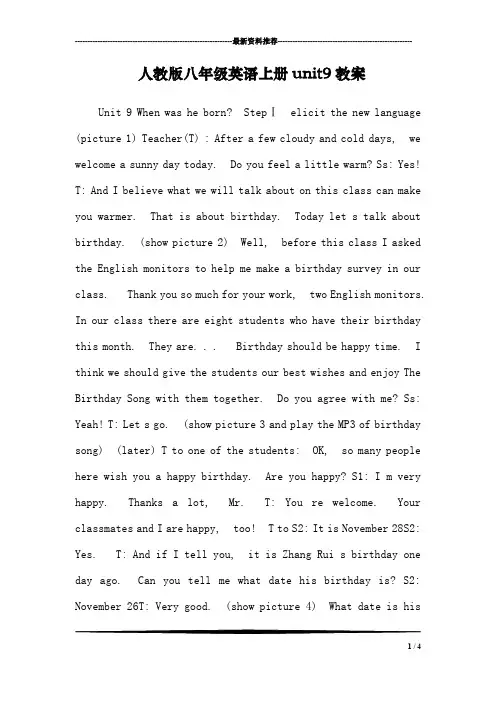
---------------------------------------------------------------最新资料推荐------------------------------------------------------人教版八年级英语上册unit9教案Unit 9 When was he born? StepⅠ elicit the new language (picture 1) Teacher(T) : After a few cloudy and cold days, we welcome a sunny day today. Do you feel a little warm? Ss: Yes! T: And I believe what we will talk about on this class can make you warmer. That is about birthday. Today let s talk about birthday. (show picture 2) Well, before this class I asked the English monitors to help me make a birthday survey in our class. Thank you so much for your work, two English monitors. In our class there are eight students who have their birthday this month. They are. . . Birthday should be happy time. I think we should give the students our best wishes and enjoy The Birthday Song with them together. Do you agree with me? Ss: Yeah! T: Let s go. (show picture 3 and play the MP3 of birthday song) (later) T to one of the students: OK, so many people here wish you a happy birthday. Are you happy? S1: I m very happy. Thanks a lot, Mr. T: You re welcome. Your classmates and I are happy, too! T to S2: It is November 28S2: Yes. T: And if I tell you, it is Zhang Rui s birthday one day ago. Can you tell me what date his birthday is? S2: November 26T: Very good. (show picture 4) What date is his1 / 4birthday? It is November 26was he born? 他出生在什么时候?And we answer it in this way He was born on November 26When was he born? He was born on November 26 StepⅡ practice the new language and summary 1 T: Well, Zhang Rui was born on November 26people? Please look at some pictures and answer my question. (show pictures5, 6, 7, 8 in turns) T: This is What does he/she do? th today. Right? th. th. That is what we learnt before. We can also say When th. OK, Read after me for 3 times. th. th. What about some famous S: He/She is a/an T: When was he/she born? Ss: He/She was born on/in T: Pretty good. Remember this, (show picture 9) When we talk about the year or the month somebody was born, we use in , and we use on when we talk about the date somebody was born. Are y ou clear? StepⅢ listening activity T: Well, do you want to see more stars? Let s go to our textbook. Turn to page53. Activity 1b (Listen and write the year the sports star was born under each photo) There are four stars here. Who are they? (The first picture, The second, The third, The last) They are all super stars. Look at 1born in 1973. You should write down 1973 in the blank. Ss: Yes! T: I will play the recording twice. For 12Ss: Yeah! T: Let s begin! (after the exercise) Have you finished? OK. Let s check the answers, and you try to answer---------------------------------------------------------------最新资料推荐------------------------------------------------------me with a whole sentence. For example, I ask you When was Deng Yaping born? You answer me Deng Yaping was born in 1973. Do you understand? S: Yeah! T: When was born? Ss1-4: He/She was born in Right or wrong? StepⅣ pair-work T: Well done, boys and girls! We knew more about four stars just now. Next lets use the information from 1b to make conversations. Look at Activity 1c (Practice the conversation about Deng below. Then make conversations about the other sports stars in 1b. ) First I ask two students read the example to the class. (later) Very good. Now use the information from 1b to make conversations with your desk-mate. st one, please. For example, you will hear that Deng Yaping was st time, you only listen. And nd time try to finish the exercise. Are you ready? (Have three pairs to present their conversations. ) StepⅤ expansion of the language practice summary 2 Wow, all the Ss did a pretty good job! Now look at the screen, please. (show picture 10) T to Ss: I am a teacher, and I was born on August 3When were you born? S2: T: Wonderful answer! Remember this, when somebody asks you When were you born? You can answer him in this way, I was born on (what date) , (what year) . Are you clear? Okay. Practice this3 / 4conversation. Find a partner and ask for his/her birthday and then tell him/her your birthday. (Make three pairs perform their dialogues. ) StepⅥ written practice Your conversations are fantastic! And I also have three little exercises here. (show pictures 11, 12) Write down your answers on your exercise book. StepⅦ draw a conclusion of this lesson OK. Just now we spent a fruitful lesson. Let s see what we learnt. (show picture 13) Take the notes please! Have you finished? And we also talked about the year some stars were born. And there are many, many other famous people. (show pictures 14) They all have spent years of hard work to be famous and successful. So I should say, Rome was not built in one day. (show picture 15) Just like the saying in China. 冰冻三尺,非一日之寒。
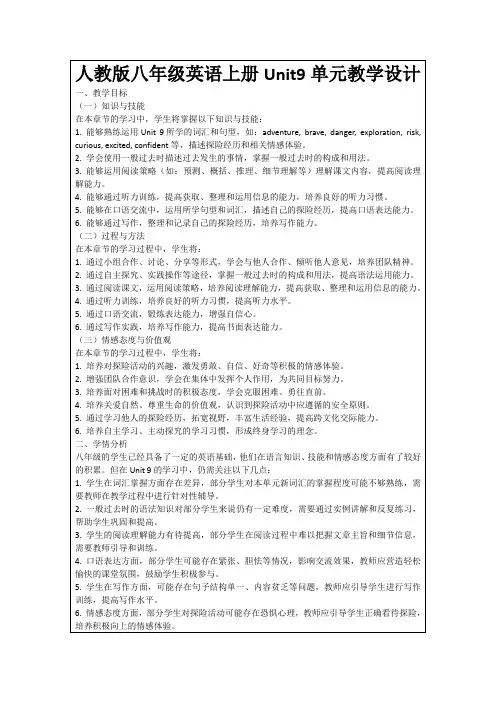
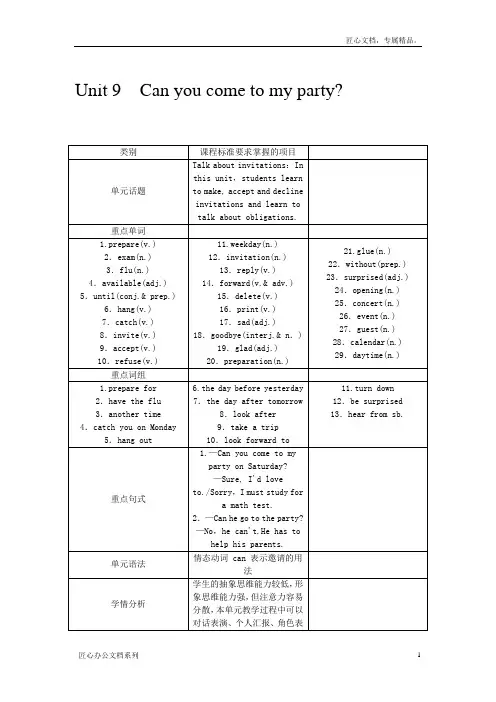
Unit 9Can you come to my party?第一课时Section A (1a~1c)§自主学习案根据句意及首字母提示完成单词。
1.She didn't go to school and stayed in bed because she had the f lu.2.Can you come and h elp me with my English?3.Can I m eet my friend tomorrow, Mom?4.I must go to see a d octor because I feel ill.5.My mother prepares for b reakfast for our family every morning.§课堂导学案Step 1准备与热身(Preparation)Hello,class.We are learning Unit 9 today.But first look at this sentence:Can you come to my party? What does it mean?You are correct. It means “你能来参加我的聚会吗?”“Can” means “能,行”. You may answer like these: Yes,I can.I can come to the party./No. I can't.I have to do my homework. In these sentences both can and have to are model verbs. They are part of the predicates.Can you come to school? Yes, I can./No, I can't.I have to see a doctor.Can you get to school by bus? Yes, I can./No, I can't.I have to walk.Step 2呈现与输入(Presentation)Please look at the picture on page 65. The boy in the middle is going to hold a party.Can everyone come to the party?Help my parents, prepare for an exam, meet my friends,have the flu, go to the doctor.Please read these expressions loudly. And match the words with the picture.Areyou OK? Let's check the answers.Step 3练习与体验(Practice)You are great ! As you see, there are some people in the picture.Do you know who's who?Now please listen to the conversation.Pay attention to Sun Ning's words carefully.He says the names of each person he is inviting. When I play the recording for the first time,you just listen carefully. When I play the recording for the second time,please write the names of each person next to his or her picture. You have to complete the activity on your own.OK, let's go!Now let's talk as they do in the conversation.In other words, we are going to talk in imitation of the conversation we have just heard and read.Step 4运用与生成(Production)Now please make your own dialogues in groups of four. Suppose you are the students in the picture. One of you is inviting the other three students to his party. The other students are saying if he can go or not.If you can't go, remember to give a reason.When you practice, please pay attention to the pronunciation and intonation.I'll offer vocabulary and pronunciation support if you need.Step 5巩固与提高(Progress)【探究点】Can you come to my party on Saturday afternoon? 你能在周六下午来参加我的聚会吗?Can you…?句型是熟人和朋友之间常用的表达邀请或请求的用语。
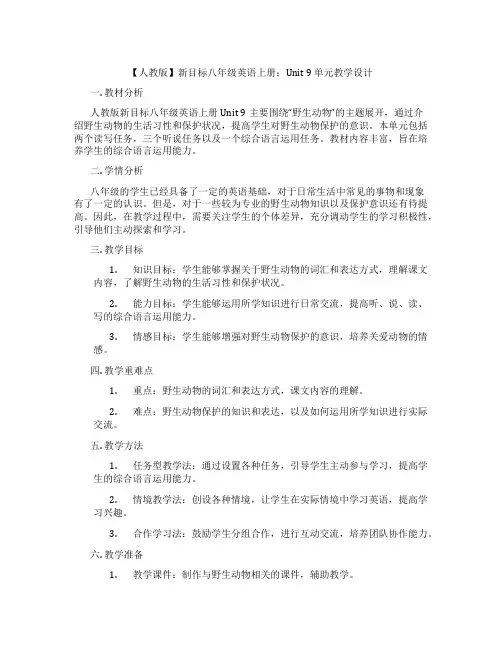
【人教版】新目标八年级英语上册:Unit 9 单元教学设计一. 教材分析人教版新目标八年级英语上册Unit 9主要围绕“野生动物”的主题展开,通过介绍野生动物的生活习性和保护状况,提高学生对野生动物保护的意识。
本单元包括两个读写任务,三个听说任务以及一个综合语言运用任务。
教材内容丰富,旨在培养学生的综合语言运用能力。
二. 学情分析八年级的学生已经具备了一定的英语基础,对于日常生活中常见的事物和现象有了一定的认识。
但是,对于一些较为专业的野生动物知识以及保护意识还有待提高。
因此,在教学过程中,需要关注学生的个体差异,充分调动学生的学习积极性,引导他们主动探索和学习。
三. 教学目标1.知识目标:学生能够掌握关于野生动物的词汇和表达方式,理解课文内容,了解野生动物的生活习性和保护状况。
2.能力目标:学生能够运用所学知识进行日常交流,提高听、说、读、写的综合语言运用能力。
3.情感目标:学生能够增强对野生动物保护的意识,培养关爱动物的情感。
四. 教学重难点1.重点:野生动物的词汇和表达方式,课文内容的理解。
2.难点:野生动物保护的知识和表达,以及如何运用所学知识进行实际交流。
五. 教学方法1.任务型教学法:通过设置各种任务,引导学生主动参与学习,提高学生的综合语言运用能力。
2.情境教学法:创设各种情境,让学生在实际情境中学习英语,提高学习兴趣。
3.合作学习法:鼓励学生分组合作,进行互动交流,培养团队协作能力。
六. 教学准备1.教学课件:制作与野生动物相关的课件,辅助教学。
2.教学素材:收集一些关于野生动物的图片、视频等素材,用于教学展示。
3.课堂活动准备:准备一些与野生动物保护相关的小游戏、小组活动等,丰富课堂氛围。
七. 教学过程1.导入(5分钟)利用图片或视频展示一些野生动物,引导学生谈论自己喜欢的动物,激发学生的学习兴趣。
2.呈现(10分钟)教师通过课件展示本节课的主要内容,包括野生动物的词汇和表达方式,以及课文内容。
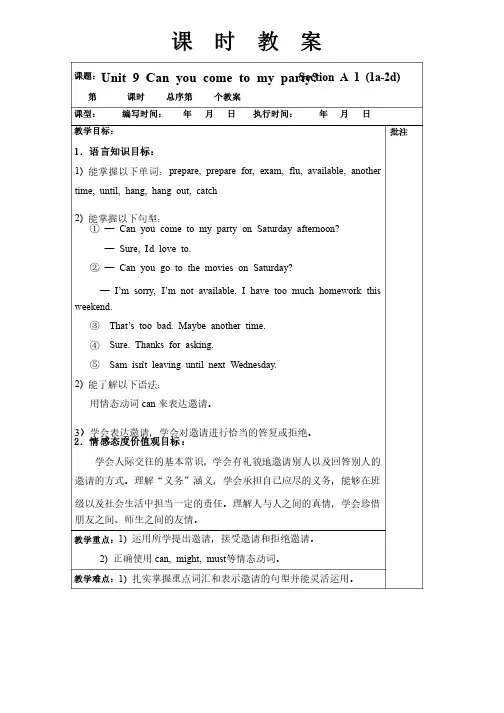
课时教案课题:Unit 9 Can you come to my party? Section A 1 (1a-2d)第课时总序第个教案课型:编写时间:年月日执行时间:年月日教学目标:1. 语言知识目标:1) 能掌握以下单词:prepare, prepare, prepare prepare prepare for, for, for, exam, exam, exam, flu, flu, flu, available, available, available, another another time, until, hang, hang out, catch 2) 能掌握以下句型:①—Can you come to my party on Saturday afternoon? —Sure, I’d love to. ②—Can you go to the movies on Saturday? —I ’m m sorry, sorry, sorry, I I ’m m not not not available. available. available. I I I have have have too too too much much much homework homework homework this this weekend. ③That That’’s too bad. Maybe another time. ④Sure. Thanks for asking. ⑤Sam isn ’t leaving until next Wednesday. 2) 能了解以下语法:用情态动词can 来表达邀请。
3)学会表达邀请,学会对邀请进行恰当的答复或拒绝。
2. 情感态度价值观目标:学会人际交往的基本常识,学会人际交往的基本常识,学会有礼貌地邀请别人以及回答别人的学会有礼貌地邀请别人以及回答别人的邀请的方式。
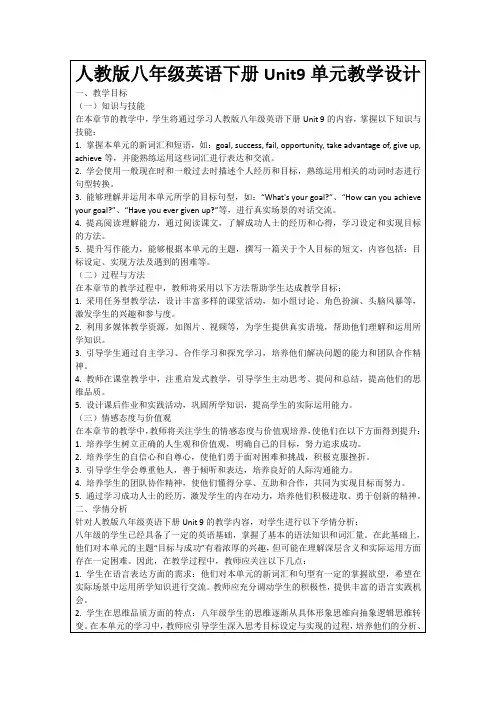
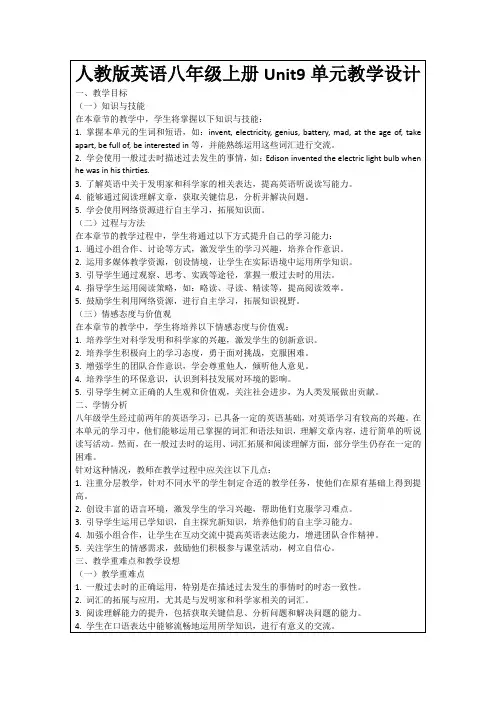
Unit 9 Have you ever been to a museum?第一课时Section A (1a2d)【学习目标】1.重点单词:amusement2.重点短语:have/has been to,have/has gone to3.重点句式:Have you ever been to a museum?Let's go somewhere different today.Frank's friend has never been to the water park.Have you ever been there?It's a great way to spend a Saturday afternoon.I learned about the inventions that led to color movies,too. We put up a tent and cooked outside.I've never been camping.【学习重点】1.重点短语和句型2.have has been to 和have has gone to 的用法3.现在完成时态【学习难点】1.have has been to 和have has gone to 的用法2.现在完成时态【自主学习】一、预习课本P6566新单词并背诵,完成下面的汉译英。
1.娱乐二、认真预习1a2d,找出下列短语和句型。
1.去过某地2.去了某地3.你曾经去过博物馆吗?4.今天让我们去一些不同的地方吧。
5.Frank的朋友从来没有去过水上公园。
6.你去过那里吗?7.这是一个度过周六下午的好方法。
8.我了解到了有关那个导致彩色电影出现的发明。
9.我们支起了一个帐篷并且野炊。
10.我从来没有野营过。
【课堂导学】Step 1情景导入(Show the pictures of amusement parks,water parks,space museums,zoos art museums,and history museums)Teacher:What can you see in the picture?(Look at the pictures and brainstorm the words they can think of,such as space museum,amusement park,water park,zoo,art museum and history museum.)T:Have you ever been to an amusement park?Ss:No.T:Now,we'll learn Unit 9—Have you ever been to a museum?环节说明:通过多媒体图画的谈论问答,并因势引导,采用师生之间的交流方式,自然导入“Have you ever been to a museum?”(“你曾经去过某地吗?”)这一话题。
八年级英语上册-人教版-Unit 9 教案一. 教材分析人教版八年级英语上册Unit 9主要围绕着“节假日”这一主题展开,通过学习本单元,学生能够掌握关于节日的词汇和表达方式,了解不同国家的节日习俗,提高听说读写的能力。
本单元包括两个阅读文本,分别是关于春节和西方节日的介绍。
二. 学情分析八年级的学生已经具备了一定的英语基础,能够听懂并运用简单的日常英语进行交流。
但部分学生在阅读和写作方面还存在一定的困难,对一些文化背景知识了解不足。
因此,在教学过程中,需要关注学生的个体差异,调动他们的学习积极性,提高他们的综合语言运用能力。
三. 教学目标1.知识目标:学生能够掌握关于节日的词汇和表达方式,了解不同国家的节日习俗。
2.能力目标:学生能够听懂、说清、读懂并写出一个关于节日的短文。
3.情感目标:培养学生对不同文化的尊重和理解,提高他们的跨文化交际意识。
四. 教学重难点1.重点:掌握关于节日的词汇和表达方式,了解不同国家的节日习俗。
2.难点:能够运用所学知识,编写一个关于节日的短文。
五. 教学方法1.任务型教学法:通过完成各种任务,激发学生的学习兴趣,提高他们的实践能力。
2.情境教学法:创设真实的语境,让学生在实践中学习,提高他们的语言运用能力。
3.文化教学法:介绍节日背后的文化背景,培养学生对不同文化的尊重和理解。
六. 教学准备1.教师准备:备好相关节日的教学材料,如图片、视频、阅读文本等。
2.学生准备:预习相关节日的词汇和表达方式,了解自己国家的节日习俗。
七. 教学过程1.导入(5分钟)教师通过提问方式引导学生谈论自己喜欢的节日,从而引出本课主题。
2.呈现(10分钟)教师展示与节日相关的图片和视频,引导学生用英语描述图片内容。
3.操练(15分钟)教师学生进行角色扮演,模拟节日场景,让学生在实际语境中运用所学知识。
4.巩固(10分钟)教师给出一个关于节日的句子,要求学生用所学的词汇和表达方式进行改写。
Unit 9 Can you come to my party?Section B 2a-2dI.The teaching objects:Knowledge objects:1.Words and phrases: invitation, make an invitation, accept an invitation, turn down an invitation, preparation, sad, surprised, look forward to, hear from, take a trip…2.Sentences:Bring Ms. Steen to the party without telling her so that she can be surprised.I look forward to hearing from you all.3.Ss will be able to learn some reading strategies.Ability objects:1. Ss can use reading strategies to comprehend the passage.2. Ss can learn to write an invitation and accept or turn down it. Emotional objects:1. Ss will be able to be polite to others when they turn down their invitations.2. Ss will be able to form the habit of holding parties for various purpose and enjoy the life.II. Teaching important points:1.Ss can master the key words, phrases and sentence structures well.2.Ss can Ss can use reading strategies to comprehend the passage.III.Teaching difficult points:Ss can use proper sentences to make, accept and turn down the invitations and give reasons correctly and fluently.IV.Teaching procedures:Warming-up and lead-in.Enjoy a short video and ask Ss : Who is the party for?Ask the students to say “Happy birthday to you, Mickey!”Task 1: Work on 2a.Make a list of the kinds of parties people have. (show some pictures) Task 2: Skimming (2b)Listen and match the reason with each message.Task 3 Careful reading (2b)Read Message 2(make an invitation), fill in the blanks, then do 2c.Invitation: A _____________ partyFor whom: __________________Time :__________________Preparation: buy _____ and ______think of _______ to play_______ things (glue, paper…) bring Ms. Steen _______telling herInvite whom: all the _________What to do in the________games, ________and ________.party:Answer the questions quickly. (2c)1. What kind of party is it?________________________________________2. Who is the party for?________________________________________3. When is the party?________________________________________4. Who did David invite to the party?________________________________________5. What can people do at the party?_______________________________________Read Message 1 (accept an invitation) and judge T or F.1. He Wei likes Ms. Steen very much.2. He Wei is very glad to see Ms. Steen go.3. He Wei would like to come to the party, but he can’t help out with any of the party preparations.4. He Wei has a good idea about how to bring Ms. Steen to the party. Read message 3 (turn down an invitation) and choose the right answers.1.Jake would like to come, but he is not ______.A. busyB. availableC. happyD. well2. Jake would be ________ to help with the party preparations.A. sadB. unhappyC. busyD. gladTask 4: Read again and sum up. (how to make, accept, and turn down an invitation)make an invitation have a _________ partyCan you _________?bring her to the party ________ telling her so ______ she can be ___________look forward ________hearing from youaccept an invitation What ______ ________ _______!be ______ to see her gothe _______ way to say “Thank you and goodbye.”turn down an invitation Thanks ______ planning this, but I’m not _________. help out ________any of the party______________ Let me ________ if you _________ my help.Task 5: Make a conversationAsk students to make a conversation in a group, try to use the phrases and sentences in the form.Task 6: Go for it!Fill in the blanks. (2d)We are planning a housewarming ________ at our new house this Saturday. Can you _______? Our house is at 2 London Road. We are serving _______ and ______ from 7:30 p.m. If you ______ your friendsand family ________ telling me. I will be ________. You know, a party is more ________ with more people! Can you come? Can you help me with the party ________? I am looking forward to ________ from you all. Task 7: WritingTurn down or accept the invitation. (the housewarming party) Homework:The Christmas is coming. Imagine you will have a party. Make an invitation to invite your classmates.Blackboard design:Unit 9 Can you come to my party?Section B 2a-2dmake an invitationaccept an invitationturn down an invitation。
Unit 9 Have you ever been to a museum?本单元教材以“曾经去过某地”为中心话题,围绕着“现在完成时态的教学”进行,学习和运用几个常见的句型:—Have you ever been to a science museum? —Yes, I have.I went to theNational Science Museum last year./— I have never been camping. — Me neither./It also encourages governments and social groups to think about ways to improve toilets in the future./ — I have been to the art museum many times. —Me , too.And I have also visited the nature museum.等。
在学习过程中,学生在交流中,能促进师生之间的感情。
Section A主要学习几个常见的动词短语及句型Have you been to…?应掌握句型:—Have you ever been to a science museum?— Yes, I have.I went to the National Science Museum last year.等。
通过一篇短文介绍了学生们曾经去过的最有趣的博物馆,增加了学生的阅读量。
Section B安排了听、说、读、写的任务, 通过短文“Singapore—A Place You Will Never Forget !”介绍了新加坡的一些情况。
教师在教学中应合理利用课本上的知识进行教学。
课时分解.第一课时Section A(1a— 2d)Teaching Key Points 【教学重点】The vocabulary :amusement, somewhere, camera, invention , history/space/art museum , put up, have a good time , water/amusement parkTarget language:1.—Have you ever been to a science museum?— Yes, I have.I went to the National Science Museum last year.2.I have never been camping.3.It's a great way to spend a Saturday afternoon.Teaching Difficult Points 【教学难点】Use the target language above to talk about past experiences.Teaching Aids 【教学工具】an English book , a tape recorder and CAITeaching Steps 【教学过程】★ Step 1 Preview and perception 【预习感知】Ask the students to read the vocabulary and target language.I .英译汉。